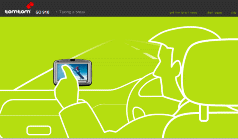 Investors.com has published an interesting article about the future of satellite navigation systems. It notes that the portable satnav unit suppliers, principally Garmin and TomTom, are busily adding features to their dashboard doohickeys in a frantic bid to make them more compelling. TomTom’s top-of-the-line GO 910 unit has a 20GB hard disk that can call up streetmaps from the
Investors.com has published an interesting article about the future of satellite navigation systems. It notes that the portable satnav unit suppliers, principally Garmin and TomTom, are busily adding features to their dashboard doohickeys in a frantic bid to make them more compelling. TomTom’s top-of-the-line GO 910 unit has a 20GB hard disk that can call up streetmaps from the
It’s not clear that buyers actually want - or want to pay for - an increased level of complexity, but the satnav makers have apparently convinced themselves that there’s no alternative. Car manufacturers are bound to make their factory-fitted navigation units cheaper and/or more functional and, as Investors.com notes, buyers who’ve become used to sucker-mount satnav are highly likely to see GPS as a worthwhile fitted option when they next buy a vehicle. And at the other extreme, navigation facilities are already creeping into PDAs and phones. TomTom and its rivals understandably feel squeezed in the middle.
Unfortunately creeping featurism is probably the wrong response: it seems much more likely that success for these firms will come from a razor focus on improving the quality of navigation, and the usability of the human-machine interface. A plug-in unit ought to be able to keep ahead of factory-fit options when it comes to state-of-the-art screens, graphics, speech recognition, intelligent rerouting, and all the other things that actually have something to do with guiding the driver to where they’re going.
A karaoke machine on the dashboard is not required.








